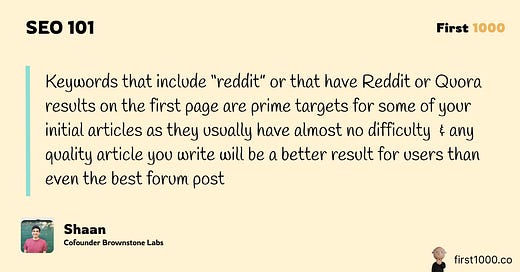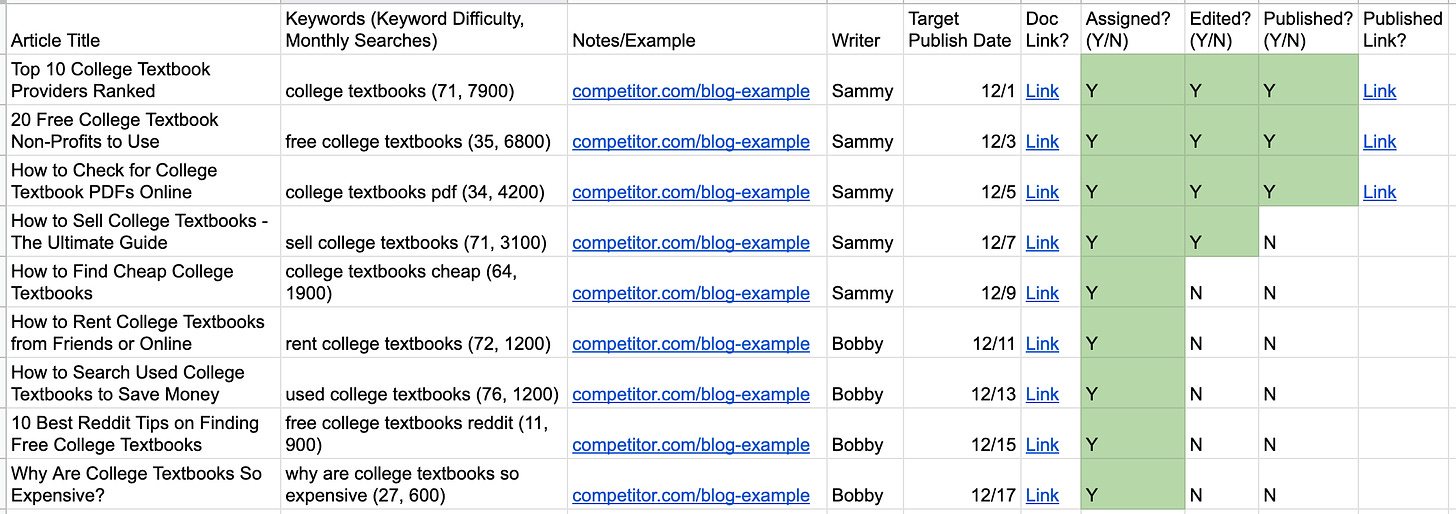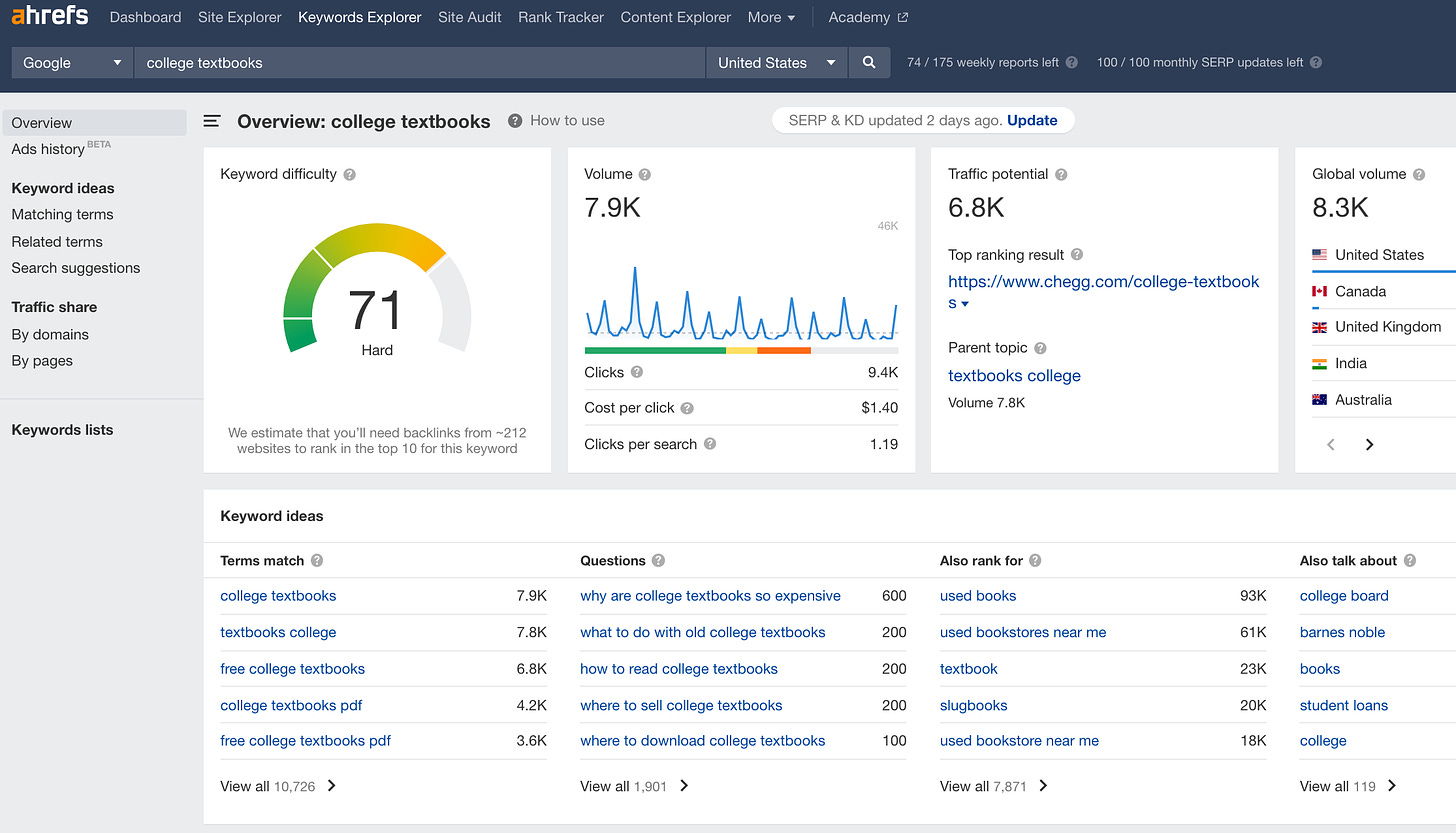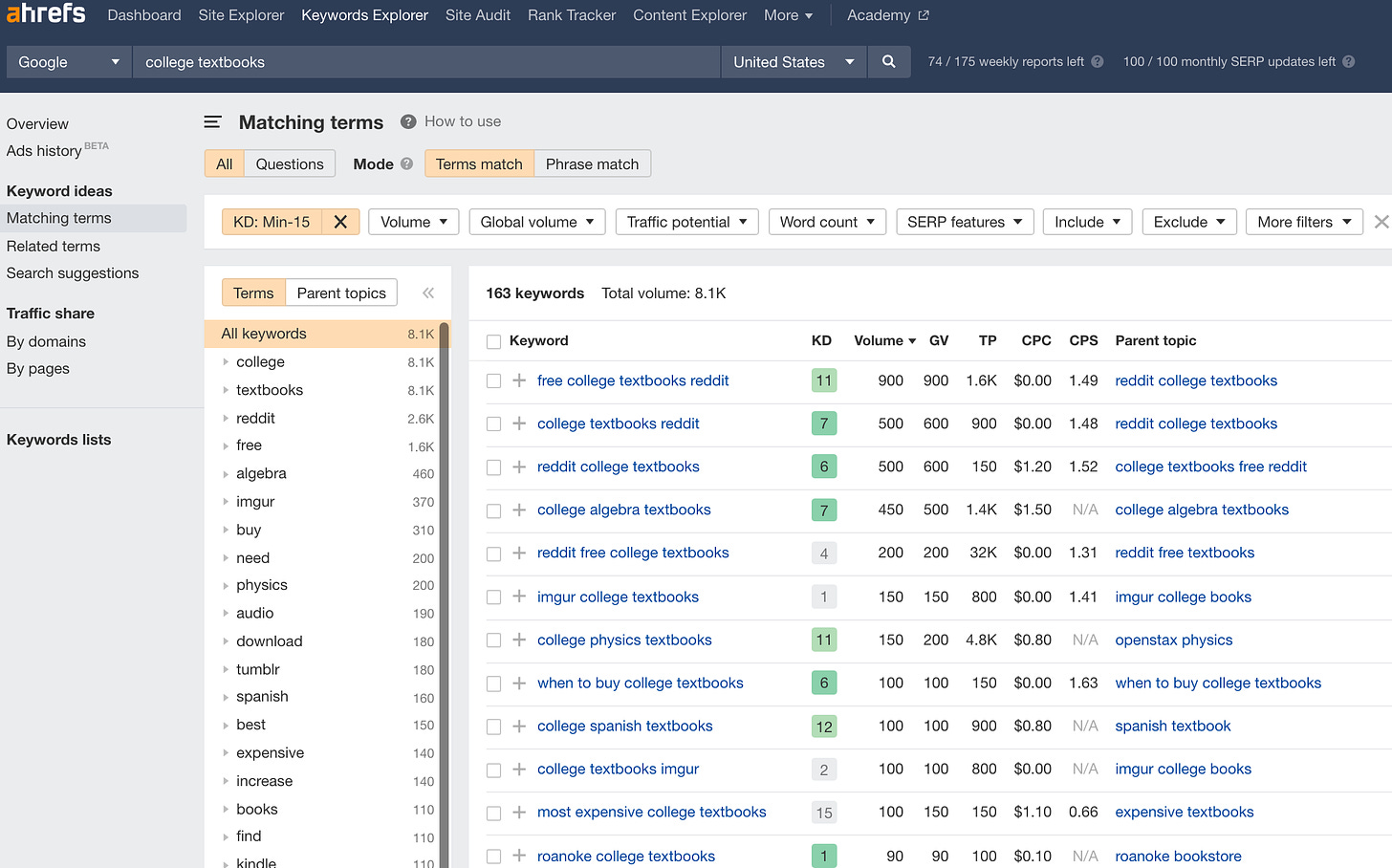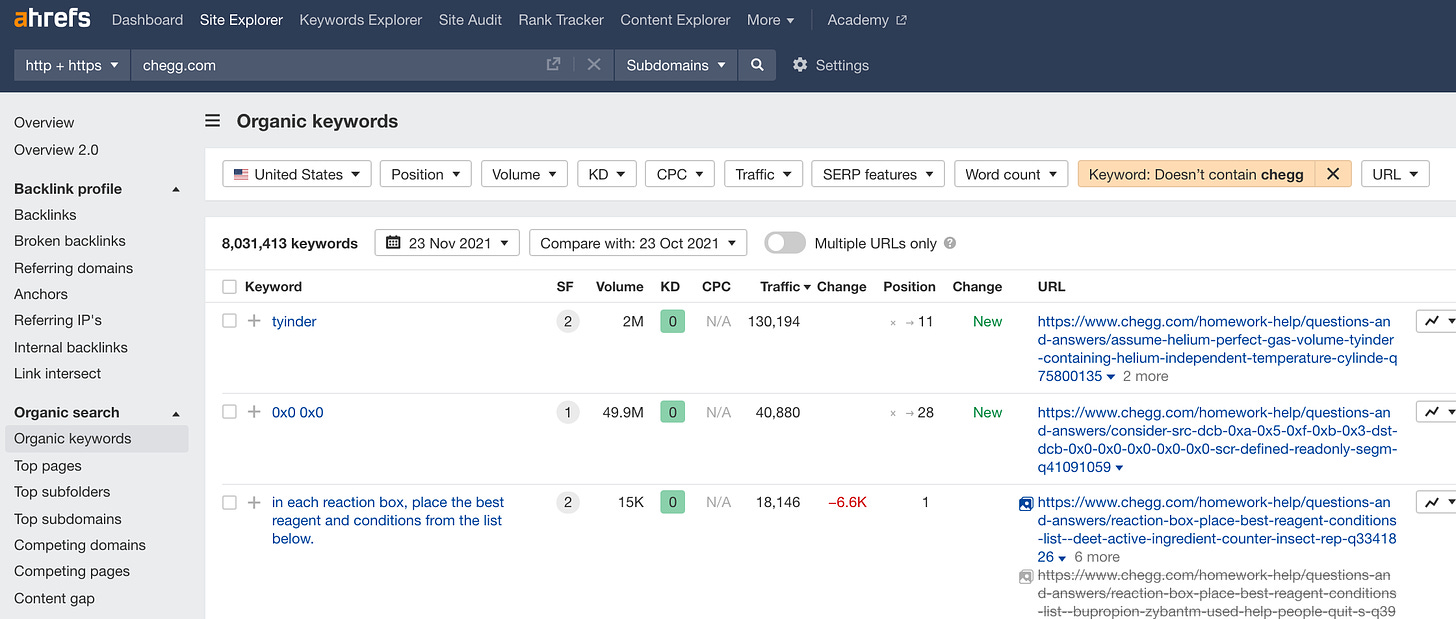By: Shaan from Brownstone Labs (SEO Consulting)
SEO - What/Why/When/How
What is SEO?
SEO stands for Search Engine Optimization.
TLDR: Google exists, people everywhere search using it, and I advise any startup/company I work with to think about how they can show up in their answers they click on.
Why SEO?
Sustainable Growth.
Predictable
In-Market and Interested
Trust and Credibility
When to Invest in SEO and Get Started - 3 Questions to Ask Yourself
Can You Ensure Focus and Investment in SEO for at Least 3-6 Months?
SEO and Content Marketing take time to get started and optimize so you won't have instant feedback.
your cost can range anywhere from $10,000-$50,000 a month depending on your industry and goals.
I know 6 months at an early-stage startup is an eternity, but remember that this long-term investment is required of everyone so it makes it harder for your competitors to follow you as well or compete and creates an SEO moat.Can You Produce High-Quality Content?
Whether I’m not writing the content myself, I always have someone on the team dedicated to writing the articles. Outsourcing is also an option, but having someone in the content trenches from the team is crucial.
Content isn't solely just all keywords and SEO.Can Your Content Machine Be Efficient?
Content marketing can have a lot of time-consuming parts especially the writing so I make sure I’m delegating the right aspects or planning realistic deadlines for publishing to not overwhelm myself.
Content Marketing and SEO are about consistent, high-quality content over the long-term, not writing 8 average-quality blog posts in one day and burning out your team for the next month.
TLDR/Summary:
Even the earliest-stage startups can benefit from getting started on content (earlier is almost always better), but you'll need to think about a 3-6 month timeline and $10k-$50k a month to really understand your early results and potential.Launching an SEO Content Machine in 5 Steps
(using just ONE google/excel sheet to manage)
Start Your Blog :
Wordpress, Ghost, Squarespace, and Wix are all useful options and have enough strengths for SEO and publishing. Don't complicate this process, ease of publishing is key and the content is what matters so focus on that.Create a Content Pipeline:
This could be a single google sheet or excel sheet to manage your whole content machine 🧠 (see below). The columns will be:Article Title
Keywords (Keyword Difficulty, Monthly Search Volume)
Notes/Example Articles
Writer
Target Publish Date
Doc Link? (link to your google doc with written draft)
Assigned? (Y/N)
Edited? (Y/N)
Published Link? (link to active blog post)
Use Ahrefs or Moz (two powerful SEO tools 🧨). I prefer Ahref.
Either start with the specific keyword you know (like your product or service) 🎯 or start with using a competitor's website 🔎 and find their content topics.
(don't be shy about writing about the same things, just create better original content and never copy).You'll need to use the Ahref keyword difficulty rating (see below). Keyword difficulty ratings measures your chance of ranking in the top 10 results based on the number of websites linking to all of the other results.
It's not a linear scale so higher scores are much harder.
Pick the right Strategy:
Generally, there are two strategies to pick from:
Keyword First Strategy (best to start).
Competitor First Strategy.
To demonstrate each strategy, I’ll use the example of being a college textbook service
a. Keyword First Strategy:You begin your keyword research by searching "college textbooks" in the Ahrefs keyword explorer tool. You end up at this page and its 71/100 keyword difficulty looks unattainable.
How do you get a variety of topics/keywords with different difficulties to target?First, look at the matching terms list and related terms list on the left-hand side (see below).
You’ll get a variety of different terms you can use in new articles. They all have varying difficulty scores.
To get low keyword difficulty topics to rank on the first page, use the "KD" filter and choose a max of 15 (see below).
Now that you have keywords that you can fill in on your Google sheet that will be relatively easy to rank on the first page.Next steps are to find example articles to add to your Google sheet by viewing individual keyword pages and search results on Ahrefs. Pick engaging article titles like "Top 10 College Textbook Reddit Tips for Students".
Useful Growth Hack 🤫: Keywords that include “reddit” or that have Reddit or Quora results on the first page are prime targets for some of your initial articles as they usually have almost no difficulty (meaning you can rank on the first page in days or even a few weeks instead of months) and any quality article you write will be a better result for users than even the best forum post. This tactic was instrumental in our latest startup client going from 0 to 20,000 recurring monthly unique visitors within 4 months.Competitor First Strategyb. Competitor First Strategy:
If you know who your top competitors are, you can find great keywords and topics just by understanding how they are getting their organic traffic.
To continue our college textbook service provider example, say your top competitor is Chegg, you can use the Ahrefs site explorer tool to look at their top organic keywords (be sure to filter out "chegg" in keyword filter as you want non-branded keywords that have chegg results not branded ones).While you shouldn't copy content from your competitors, you should think about targeting similar topics and keywords. If it's working for them, it may work for you if you put more effort into producing superior content.
TLDR/Summary: No matter whether you start by searching with a keyword or competitor website, you can quickly come to a list of relevant keywords and topics of lower difficulty that you can begin to target with your future content.Backlinking/Optimizing
While I could write multiple new essays on backlinking and optimizing content, overall it's important to spend some time finding someone to link to you. You can use a variety of methods, but they all involve receiving a quality link from a website with a certain Ahrefs domain rating (DR) above a certain standard, I would say above DR 35. You must also always check to see if a website looks too scammy to ask for a link or if there other conflicts.Finally, especially in competitive industries, it's important to constantly refresh content every 6 months-1 year to ensure it keeps climbing the search engine rankings. Refreshing content should mean adding new sections, updating old references to new numbers, and fixing any technical SEO issues you may see.
Useful Growth Hack 🤫: Get Backlinks from Friends, VCs/Investors, Advisors, and Your College/Alma Mater. College Domains (especially .edu) and VC Domains are some of the most useful in terms of the strength of their backlink profile and link authority so make sure your investors and advisors/professors link to you. This is an easy way to make a great start before reaching out to reporters/blogs that also will help promote your story and give you backlinks.
Producing SEO Content Internally v.s Outsourcing?
This is a constant question I receive. The answer it depends.
If you or your team members feel that you are such unique experts on your product or space and it is difficult to learn, it may be best to produce the content in-house. Spending some time writing articles yourself can help you understand your potential customers as well, but it shouldn't be overwhelming and freelance writers can be always be useful.
2 Tips for Producing SEO Content In-House 🏡:
Set realistic timelines/deadlines and don't be afraid to outsource if you find article writing is not one of your major skills. Track how much time you spend and see what parts you can automate away 🤖.
Be consistent 📅. While you are saving content production costs by creating it with existing team members, because of this divided focus, you are more likely to not stick with frequent, regular content publishing over the long-term. It's vitally important that you have dedicated time on your team to focus on content production or it risks being neglected due to other more short-term priorities.
2 Tips for Outsourcing SEO Content Production 🌐:
While many will debate the merits of hiring domestic vs foreign writers or writers with certain levels of industry knowledge vs generalists, that shouldn't be your concern. To hire skilled and useful freelancers, test them! Guarantee each promising freelancer you talk to payment for one article and then move forward long-term with freelancers you like best based on that first content piece. No process is perfect, but this helps ensure that you will be receiving the quality content you expect in the long-term.
Outsourcing can be great for writing and editing, but you must provide the correct inputs 🔢 such as relevant keywords, topics, example articles, and notes on how your freelancers should position your service/product in the article to achieve that high-quality standard. Set yourself up for success by providing the right context for your outsourced team to thrive.
TLDR/Summary:
Content Marketing and SEO aren't easy, but they can worthwhile and if you follow my strategy I have just discussed, you will be able to invest in SEO in a smart way so that you are less likely to be disappointed with your early results.
Thanks again to Ali for letting me contribute.
If you or your startup needs any help building and executing this SEO content strategy, feel free to contact me on my agency's website at BrownstoneLabs.com. We love talking to new companies!
—
Thanks Shaan for this awesome guide. If you need help with your SEO, BrownstoneLabs is definitely the place to go.
I hope you found this as useful as I did, I personally wish I had paid more attention to SEO earlier when I was getting started with First 1000. The good news is that it is never too late, SEO now contributes to more than 35% of the growth at First 1000.
Until next week 😉,
Ali Abouelatta

